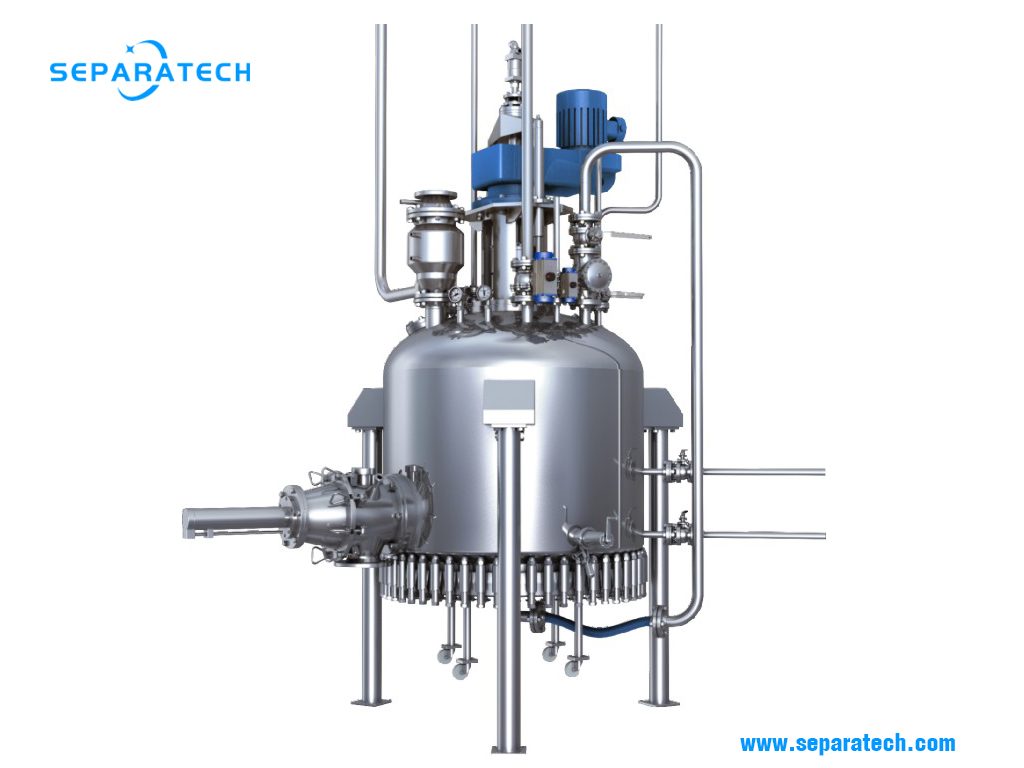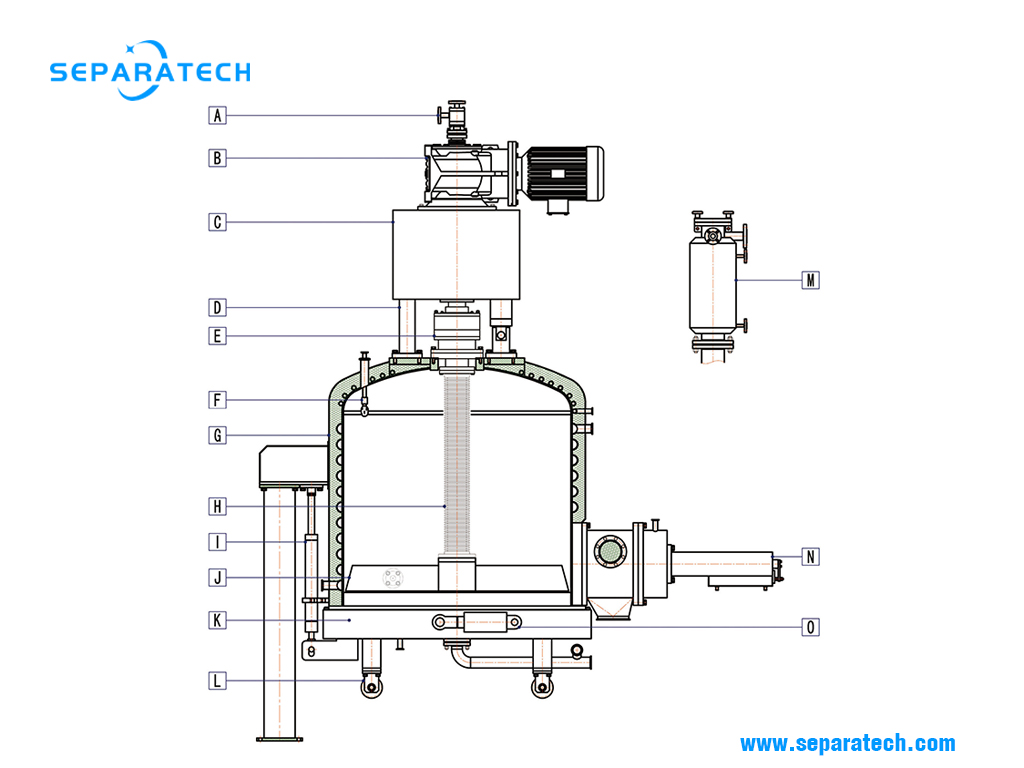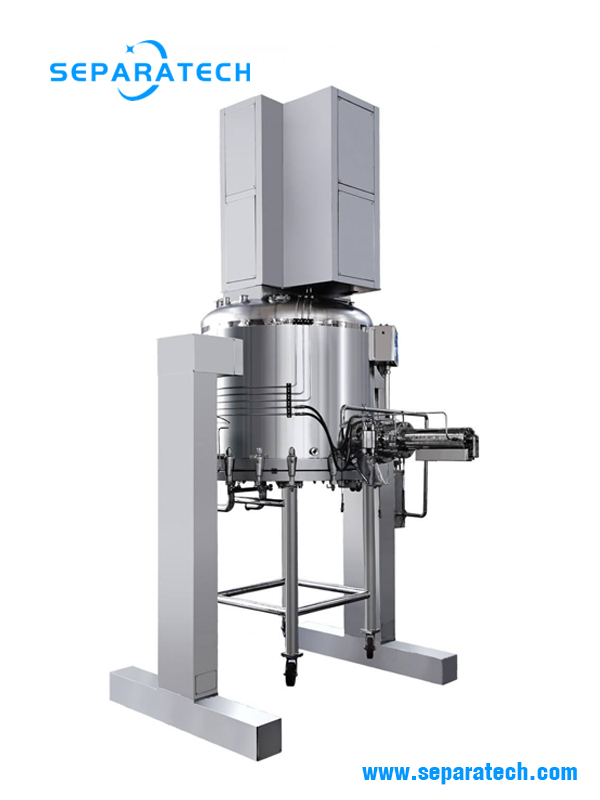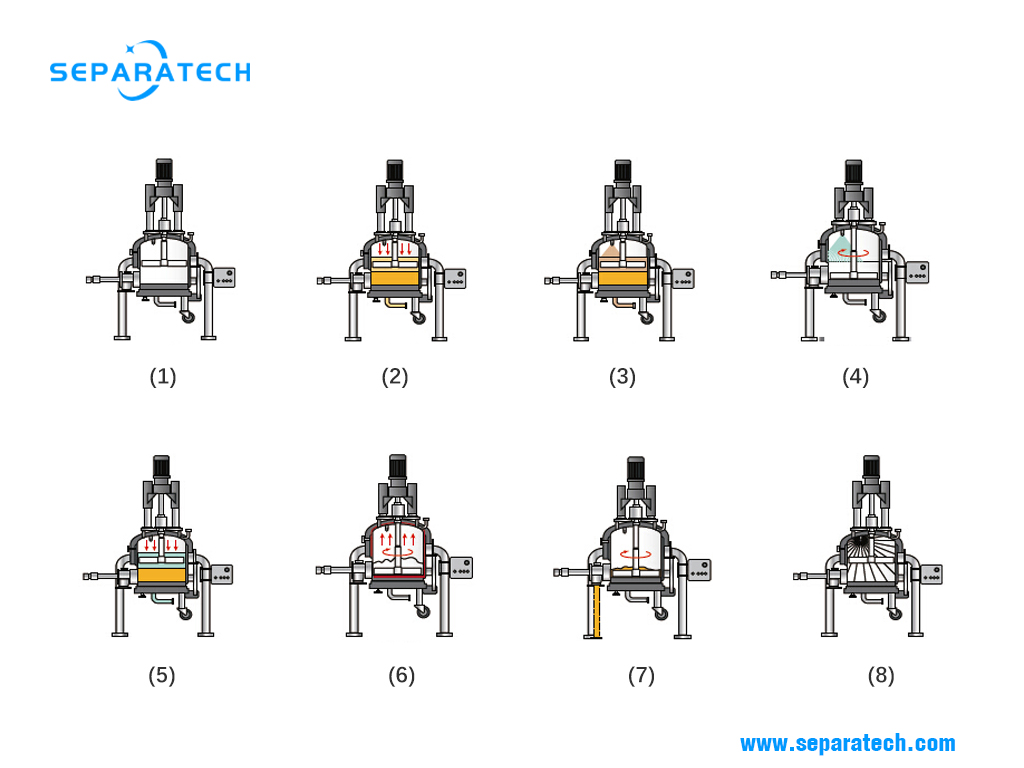Agitated Nutsche Filter Dryers (ANFD)

What is a Nutsche Filter?
Agitated Nutsche Filter is a machine used to separate solids from a slurry by using positive pressure. Liquid of the slurry is forced through a screen or cloth so that the solids can be collected.
The Nutsche Filter is the industrial version of the well-known laboratory scale Buchner Funnel except that it is designed to operate under either on vacuum or pressure.
Applications
The Nutsche Filter is the industrial version of the well known laboratory scale Buchner Funnel except that it is designed to operate under either on vacuum or pressure. In their modern version they were developed in the early 80’s and the majority operates, usually under pressure, in batch oriented industries such as fine chemicals, dyes, pharmaceutics and pesticides.
Key Components

A swivel joint
B drive unit
C frame
D hydraulic lifting device
E mechanical seal
F CIP device
G pressure tank
H Bellows
I Tank Bottom Lifting Device
J paddle
K hydraulic locking flange
L tank bottom pulley
M dust collector
N hydraulic discharge device
0 hydraulic locking device
Modern Agitated Nutsche Filter Dryers are typically comprised of five chief components:
Jacketed Pressure Vessel
For positive pressure or low vacuum levels with high sealing efficiency.
Bi-directional Agitator
With an adjustable stroke; each direction providing a different process effect on the product.
Base Filtration Element
Which can take various configurations and pore sizes to accommodate different product profiles.
Heating Elements
For temperature control (heating or cooling down) of the process.
Discharge Plug/Valve
Which must be suitably designed to allow maximum product recovery yield.
These are the essentials, but various additional parts are available where necessary, such as bayonet plugs for faster maintenance turnaround, integrated process cameras for more efficient method control, and dust filters for containment of high active ingredients. All these components may be constructed from exotic materials of construction and heated to meet the process requirements.

Operational Sequence

1. Filling
The first step involves the transferring of the product to be filtered, usually an aqueous or solvent based solid/liquid slurry, from the primary location (e.g. reactor) to the agitated nutsche filter. The nutsche filter should be sized appropriately to handle the solids volume that is being charged. A general rule of thumb to follow is that the maximum solids height should be equal or less than the agitator stroke.
2. Filtration
This step involves the use of pressure and/or vacuum to force liquid through the solid bed and filter media. The agitated nutsche filter is charged with slurry and pressure is applied to displace the filtrate leaving the cake retained over the filter medium. The process is stopped when solids are visible, or can be continued until all the liquid is pushed out. There are various types of filter media available in nutsche filters – cloth, single layer metal screen, or multi-layer sintered metal. The media should be determined based on the characteristics of the slurry including particle size and shape, cake porosity, and compressibility (which are all factors that, when taken into account with the filter media selected, will determine filtration rate).
For slurries with a wide distribution of coarse fast settling solids and slow settling fines there is a risk of segregation with the finer fraction settling over the coarse fraction. When this happens the fines seal the cake and slow down the cake formation so keeping the slurry in suspension with rotating arms of agitated nutsche filter during filtration assists in forming a homogeneous cake.
3. Cake Washing
In the washing stage a spray ring or connections on top of the cover introduce the wash liquid over the cake. The liquid is forced through with pressure or vacuum.This displaces the mother solution with the wash liquid but with such in-situ washing the efficiency may be quite low if the cake forms with an uneven thickness. Washing efficiency may be further improved if air or gas are not allowed to enter the cake in a multi-washing system. Displacement washing serves several purposes – it removes the liquid and its impurities while keeping the cake intact and it replaces the previous liquid with fresh liquid.
One of the advantages of the Agitated Nutsche Filter is the ability to smoothen the cake’s surface prior to applying spray wash so that the entire bed is washed evenly.
4. Cake Repulping
Many processes require high washing efficiency to remove the contaminating liquid from the product and washing the cake by repulping yields the most efficient product purity. This is executed by the addition of fresh wash liquid that is mixed with the solids. This is done by resuspending the cake with the paddle arms for thorough mixing with the wash solution. During resuspension the rotating arms are moving slowly downwards and are “shaving” the bed gradually layer after layer until the entire cake enters the slurry.
5. Pressure Drying
In the drying stage air or gas purges the cake until the captive moisture is reduced to an asymptotic level and in practical terms the cake is considered to be as dry as possible. During convection drying, hot, pressurized gas (usually nitrogen) is blown down through solids and out of filtrate lines (and even recirculated as necessary); this will eventually dry the solids. Convection drying is unique to agitated nutsche filter due to their porous filter plate.
To obtain minimum moisture the cake in the agitated nutsche filter is smoothened by reversing the rotation of the paddle or auger arms and exerting controlled pressure on its surface with the hydraulic system. This seals cracks in the cake so that air or gas will not bypass the bed. This function will help to achieve uniform flow of liquid or gas through the filter cake, while helping to eliminate liquid and gas channelling that reduces the efficiency of displacement washing and gas blow through.
6. Vacuum Drying
Vacuum drying, the most common method, involves a vacuum source, agitation, and dust filter. This type of drying utilizes vacuum to reduce the temperature at which the solvent evaporates, reducing the average drying temperature.
by slowly rotating and lowering the paddle arms to scrape and delump the cake, to archeve further reduction in cake moisture. To take advantage of the drying ability of the Agitated Nutsche Filter it is worth considering the option of heating components such as the vessel, filter floor and paddles to enhance drying.
7. Cake Discharge
Once all the stages are completed the cake discharge valve opens and the paddle arms on the smaller machines or the auger arms on the larger ones are rotated and lowered to convey the dry cake towards the center. The same procedure also applies to side discharge machines however it should be noted that in this case the cake comes out intermittently and not continuously. This may have a layout impact on the downstream facility such as the conveyor that handles the product to storage.
There are certain applications where the desired product to be discharged is not a dry solid. Agitated Nutsche Filter Dryer is designed to facilitate flexible discharge, which allows for wet solids, slurries, or even liquid to be discharged.
On some Agitated Nutsche Filters the cloth or woven mesh screen may be backwashed with water to dislodge and remove any cake residue that adhered to the medium after cake discharge.
8. CIP / SIP process
After all the filtering work is completed, the agitated nutsche filter can automatically or manually enter the CIP / SIP sequence to clean the machine thoroughly. For some filtration applications, the SIP function is also optional.
Your benefit
Nutsche Filters are constructed to perform a multitude of tasks including reaction, filtration, cake washing and thermal drying on a single unit. As such these are very sophisticated machines with tight process control on parameters such as pressure, temperature and pH.
Nutsche Filters are well suited for handling flammable, toxic, corrosive and odor-noxious materials since they are autoclaved and designed for use in hazardous and ex-proof environments when extremely safe operation is required.
Specifications
Nutsche Filters are available in almost any size with the larger machines for a slurry filling batch of 25 m3 and a cake volume of 10 m3. Such filters have a filtration area of 15 m2 and are suitable for fast filtering slurries that produce readily 0.5 m thick cakes.
| Designation | Filtration area (m2) | Cylinder diameter (mm) | Effective volume (m3) | Cake thickness (mm) | Blade stroke (mm) | Motor power (Kw) | Weight (Kg) |
|---|---|---|---|---|---|---|---|
| ANF300 | 0.075 | 325 | 0.015 | 100 | 125 | 0.37 | 600 |
| ANF500 | 0.185 | 500 | 0.08 | 150 | 200 | 1.5 | 1500 |
| ANF600 | 0.275 | 600 | 0.2 | 150 | 200 | 2.2 | 1800 |
| ANF800 | 0.5 | 800 | 0.35 | 150 | 200 | 3 | 2000 |
| ANF1000 | 0.785 | 1000 | 0.6 | 200 | 250 | 5.5 | 2750 |
| ANF1200 | 1 | 1200 | 1 | 200 | 250 | 5.5 | 3750 |
| ANF1600 | 2 | 1600 | 2 | 250 | 300 | 15 | 5750 |
| ANF2000 | 3 | 2000 | 3 | 300 | 350 | 18.5 | 8250 |
| ANF2400 | 4.5 | 2400 | 5 | 300 | 350 | 22 | 11000 |
| ANF2600 | 5.25 | 2600 | 6 | 400 | 450 | 22 | 13000 |
| ANF2800 | 6 | 2800 | 7.5 | 400 | 450 | 30 | 14000 |
| ANF3000 | 7 | 3000 | 8.5 | 400 | 450 | 30 | 16500 |
| ANF3200 | 8 | 3200 | 10 | 500 | 550 | 37 | 18000 |
| ANF3600 | 10 | 3600 | 12.5 | 500 | 550 | 45 | 20000 |